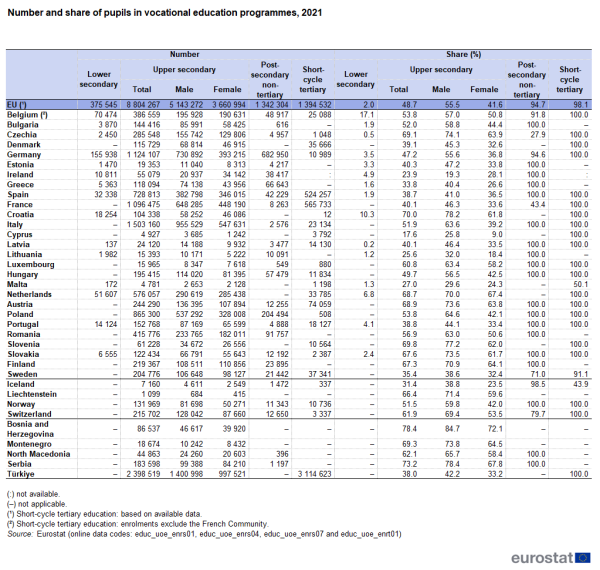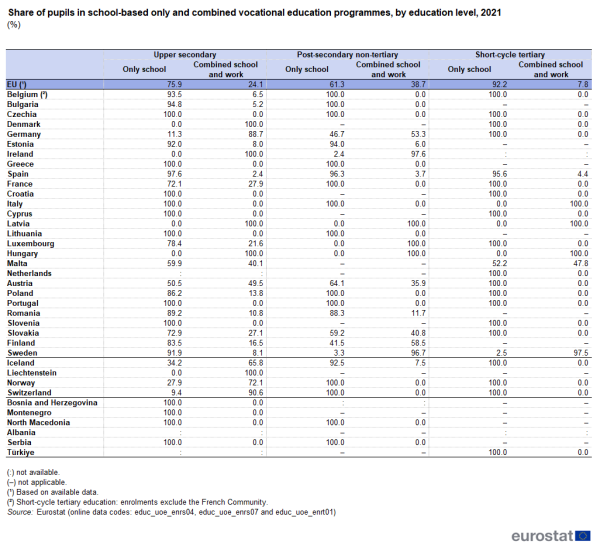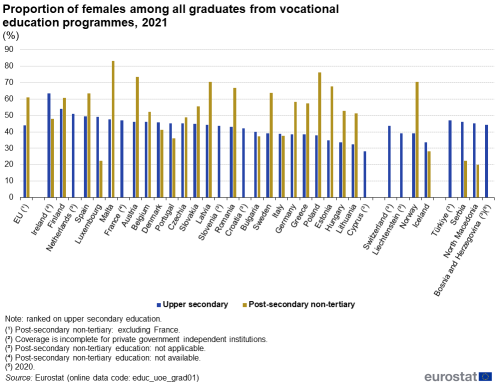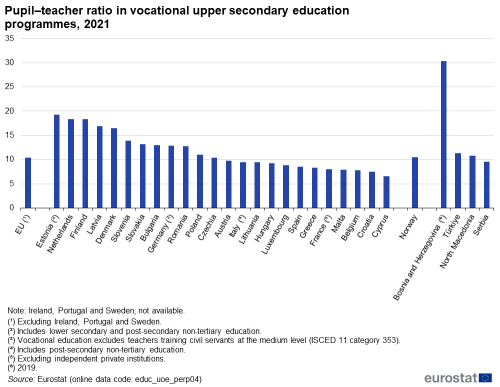Vocational education statistics
Data extracted in July 2023.
Planned article update: September 2024.
Highlights
In 2021, 2.0 % of pupils in lower secondary education across the EU followed vocational programmes, with this share reaching 48.7 % for upper secondary education and 94.7 % for post-secondary non-tertiary education.
In 2021, 43.9 % of all graduates from vocational programmes in upper secondary education in the EU were female, while the share was higher (61.2 %) among graduates from vocational programmes in post-secondary non-tertiary education.
Proportion of females among all graduates from vocational education programmes, 2021
This article presents statistics on vocational education in the European Union (EU) and forms part of an online publication on education titled Education and training in the EU - facts and figures. It analyses vocational education of pupils/students in schools or other educational institutions. This education may be undertaken as part of secondary, post-secondary non-tertiary education or short-cycle tertiary education.
Full article
Vocational training within secondary, post-secondary non-tertiary and short-cycle tertiary education
This article looks at vocational education within secondary, post-secondary non-tertiary and short-cycle tertiary education, typically within educational institutions: generally, this concerns initial education before a person enters the labour market for the first time, although it may also include adult education. These education levels are covered by the international standard classification of education (ISCED) levels 2–5. Vocational educational programmes are distinguished from general educational programmes, as the former are specifically designed for pupils to acquire the knowledge, skills and competencies for a particular occupation or trade.
Enrolled pupils

Source: Eurostat (educ_uoe_enrs01), (educ_uoe_enrs04), (educ_uoe_enrs07) and (educ_uoe_enrt01)
Within lower secondary education (ISCED level 2), vocational programmes were relatively rare across the EU: in 2021, 2.0 % of all pupils at this level were enrolled in such programmes. The majority (56.1 %) of enrolments were for boys.
Vocational programmes were more common within upper secondary education (ISCED level 3), accounting for 48.7 % of all pupils at this level in 2021. As for lower secondary education, a majority (58.4 %) of enrolments in vocational programmes within upper secondary education were for boys. More than half (55.5 %) of all boys enrolled in upper secondary education were following vocational programmes, compared with just over two fifths (41.6 %) of girls in upper secondary education.
Vocational programmes were much more common in post-secondary non-tertiary education (ISCED level 4), accounting for 94.7 % of all pupils at this level in 2021. In 16 of the 21 EU Member States with post-secondary non-tertiary education, all of the pupils at this level were enrolled in vocational programmes. A majority (58.0 %) of enrolments were female.
Vocational programmes were most common in short-cycle tertiary education (ISCED level 5), accounting for 98.1 % of all students at this level in 2021. In 18 of the 20 EU Member States with short-cycle tertiary education, all of the pupils at this level were enrolled in vocational programmes.

(%)
Source: Eurostat (educ_uoe_enrs04), (educ_uoe_enrs07) and (educ_uoe_enrt01)
Vocational programmes may be classified as only school or combined school and work. If the school component makes up 75 % or more of the total study time, the programme is classified as school-based whereas combined school and work programmes are ones where the work component makes up more than 25 % but not more than 90 % of the total study time.
In the EU in 2021, the share of students of vocational education programmes that participated in combined school and work programmes was around one quarter (24.1 %) in upper secondary education and almost two fifths (38.7 %) in post-secondary non-tertiary education. By contrast, in vocational programmes within short-cycle tertiary education the share was much lower, at 7.8 %.
In 8 of the 26 EU Member States for which data are available, all of the upper secondary pupils enrolled in vocational programmes were in school only programmes. This share was also over three quarters in a further nine Member States. There were five Member States where less than half of upper secondary pupils enrolled in vocational programmes were in school only programmes.
In 9 of the 21 EU Member States with post-secondary non-tertiary education, all of the pupils at this level enrolled in vocational programmes were in school only programmes. This share was also over half in a further five Member States. In Sweden and Ireland the share of post-secondary non-tertiary pupils enrolled in vocational programmes who were in school only programmes was 3.3 % and 2.4 %, respectively, while in Luxembourg, Latvia and Hungary all such pupils were enrolled in combined school and work programmes.
In 20 of the 26 EU Member States for which data are available, there were short-cycle tertiary educational programmes. In 14 of these, all of the students at this level enrolled in vocational programmes were in school only programmes. This share was slightly lower (95.6 %) in Spain and just over half (52.2 %) in Malta. In Sweden, the share of short-cycle tertiary students enrolled in vocational programmes who were in school only programmes was 2.5 %, while in Italy, Latvia and Hungary all such pupils were enrolled in combined school and work programmes.
In 14 EU Member States, vocational programmes exist across all three levels of education shown in Table 2.
- In Czechia and Portugal, all pupils/students enrolled in vocational programmes were in school only programmes in each of the three levels.
- In Belgium, Spain, France, Austria, Poland and Slovakia, a majority of pupils/students enrolled in vocational programmes were in school only programmes in each of the three levels.
- In Italy, all pupils enrolled in vocational programmes in upper secondary and post-secondary non-tertiary education were in school only programmes while all students enrolled in short-cycle tertiary education vocational programmes were in combined school and work programmes.
- In Luxembourg, a majority or all pupils/students enrolled in vocational programmes in upper secondary and short-cycle tertiary education were in school only programmes while all pupils enrolled in post-secondary non-tertiary vocational programmes were in combined school and work programmes.
- In Sweden, a majority of pupils enrolled in vocational programmes in upper secondary education were in school only programmes while a majority of pupils/students enrolled in post-secondary non-tertiary or and short-cycle tertiary education vocational programmes were in combined school and work programmes.
- In Germany, all students enrolled in vocational programmes in short-cycle tertiary education were in school only programmes while a majority of pupils enrolled in upper secondary or post-secondary non-tertiary education vocational programmes were in combined school and work programmes.
- In Latvia and Hungary, all pupils/students enrolled in vocational programmes were in combined school and work programmes in each of the three levels.
Graduates from vocational programmes

(%)
Source: Eurostat (educ_uoe_grad01)
In 2021, 43.9 % of all graduates from upper secondary vocational programmes in the EU were female – see Figure 1. Among the EU Member States, typically between one third and one half of graduates were female. The lowest share was 28.3 % in Cyprus, while a share just above half was recorded in the Netherlands (50.9 %), with higher shares observed in Finland (54.0 %) and Ireland (63.5 %).
A similar comparison for post-secondary non-tertiary graduates shows a higher share of female graduates. In 2021, more than two fifths (61.2 %) of post-secondary non-tertiary graduates in the EU (excluding France) were female. Furthermore, there was a wider range between the values for the EU Member States. The share of female graduates from vocational programmes was lowest in Luxembourg, at 22.5 %. By contrast, female graduates accounted for approximately three quarters of all post-secondary non-tertiary graduates from vocational programmes in Austria (73.4 %) and Poland (76.3 %), and for more than four fifths (83.1 %) in Malta.
Pupil–teacher ratios for vocational programmes

Source: Eurostat (educ_uoe_perp04)
The pupil–teacher ratio for vocational upper secondary education programmes in the EU averaged 10.4 pupils per teacher (excluding Ireland, Portugal and Sweden) in 2021 – see Figure 2. This ratio ranged across the EU Member States from 6.6 pupils per teacher in Cyprus to 18.3 pupils per teacher in the Netherlands and Finland and 19.3 pupils per teacher in Estonia (note the broader coverage of statistics for Estonia in Figure 2).
Recent pupil–teacher ratios are also available for post-secondary non-tertiary vocational education for 15 EU Member States (they are not shown in Figure 2). In 2021, the highest ratios were observed for Romania (61.0 pupils per teacher) and Poland (39.0 pupils per teacher), while the lowest ratio was observed in Bulgaria (2.6 pupils per teacher).
Source data for tables and graphs
Data sources
Sources
The standards for international statistics on education are set by three international organisations:
- the United Nations Educational, Scientific, and Cultural Organization (UNESCO) institute for statistics (UIS);
- the Organisation for Economic Co-operation and Development (OECD);
- Eurostat, the statistical office of the EU.
The source of data used in this article is a joint UNESCO/OECD/Eurostat (UOE) data collection on education statistics and this is the basis for the core components of Eurostat’s database on education statistics; in combination with the joint data collection Eurostat also collects data on regional enrolments and foreign language learning.
More information about the joint data collection is available in an article on the UOE methodology.
Classification
The international standard classification of education (ISCED) is the basis for international education statistics, describing nine different levels of education.
Within ISCED 2011, two categories of programme orientation are identified for ISCED levels 2–5: general and vocational educational programmes.
Key concepts
Vocational education programmes are designed for learners to acquire the knowledge, skills and competencies specific to a particular occupation, trade, or class of occupations or trades. Vocational education may have work-based components (such as apprenticeships or traineeships). Successful completion of such programmes leads to vocational qualifications that are labour market relevant and acknowledged as occupationally oriented by the relevant national authorities and/or the labour market.
Vocational programmes may be classified as only school or combined school and work.
- Where the school component makes up 75 % or more of the total study time, the programme is classified as school-based. The teaching may be in a school environment or through distance education.
- Combined school and work programmes are ones where the work component makes up more than 25 % but not more than 90 % of the total study time; in other words, the school learning must be at least 10 %.
A graduate is an individual who has successfully completed an education programme.
Pupil–teacher ratios are calculated by dividing the number of full-time equivalent pupils in each level of education by the number of full-time equivalent teachers at the same level; this ratio should not be confused with average class size, which refers to the number of pupils in a given course or classroom.
Context
Copenhagen process and European initiatives
Since 2002, national authorities and social partners from European countries have taken part in the Copenhagen process which aims to promote and develop vocational education and training (VET) initiatives.
For more information, see the article on Education and training statistics introduced.
One of the targets for the EU within the European Education Area (EEA) is that the share of recent graduates from vocational education and training benefiting from exposure to work-based learning during their vocational education and training should be at least 60 %, by 2025. This covers the age group 20–34 and concerns persons having left education and training 1–3 years previously.
Direct access to
- Participation in education and training (educ_part)
- Pupils and students - enrolments (educ_uoe_enr)
- Education personnel (educ_uoe_per)
- Teachers and academic staff (educ_uoe_perp)
- Education and training outcomes (educ_outc)
- Graduates (educ_uoe_grad)
- Participation in education and training (educ_part)
Metadata
- Pupils and students - enrolments (ESMS metadata file – educ_uoe_enr_esms)
Manuals and other methodological information
- Classification of learning activities – Manual – 2016 edition
- International Standard Classification of Education (ISCED) 2011
- ISCED 2011 Operational Manual – Guidelines for classifying national education programmes and related qualifications
- UOE data collection on formal education – Manual on concepts, definitions and classifications – 2022 edition
- UNESCO OECD Eurostat (UOE) joint data collection – methodology
- Regulation (EC) No 452/2008 of 23 April 2008 concerning the production and development of statistics on education and lifelong learning
- Commission Regulation (EU) No 912/2013 of 23 September 2013 as regards statistics on education and training systems
- Summaries of EU Legislation: statistics on education and lifelong learning
- European Education and Culture Executive Agency (EACEA)
- European Commission – European Education Area – Strategic framework for European cooperation in education and training towards the European Education Area and beyond (2021–2030)
- European Commission – European Education Area – Vocational education and training
- European Commission – Erasmus+
- CEDEFOP – European Centre for the Development of Vocational Training
- OECD – Education, see:
- UNESCO – Education transforms lives